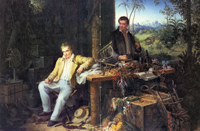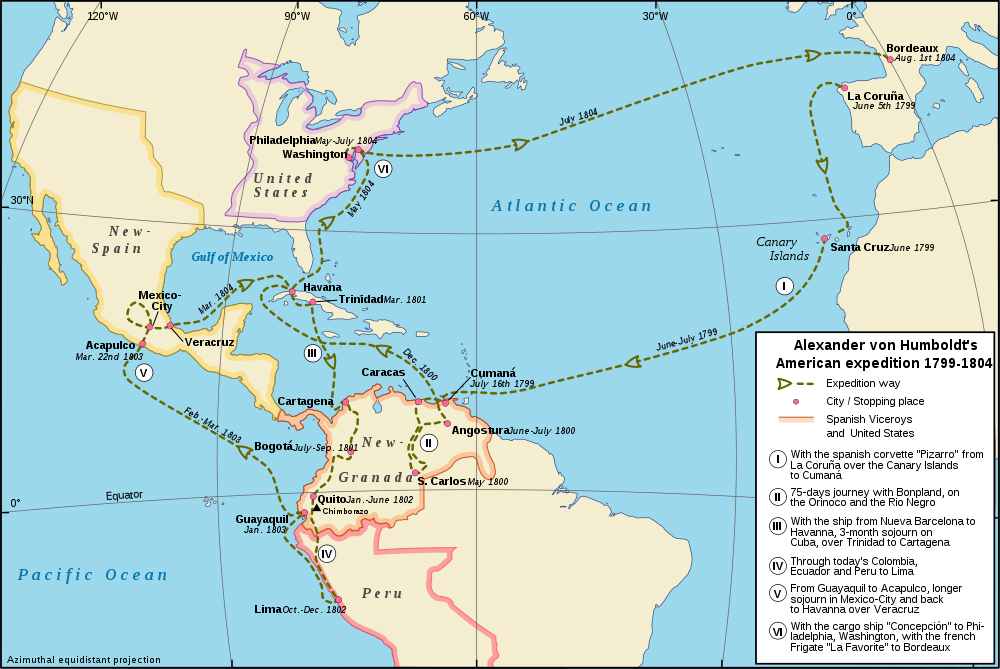Meeting 8 • 30 January 2014
|
Version: |
|
pictures of the week |
|
|
|
mini-text of the week (start): "The destruction of the forests… forcefully explains why the present Lake Valencia is decreasing.…"Humboldt, "Personal Narrative", from Jaguars and Electric Eels, ed. & trans. Wilson, p. 31 (read more) |
|
•+(10') Thought-bite of week (and pictures of the week): Life-forms elsewhere/ "elsewhen": how to fit them into current organization or, if they don't fit, how to re-organize the organization. Now that everybody (?) is on board the Humboldt SINQ Canoe, we'll get to the "sustainable environmentalism" part. Key points: "noticing" (observing, gathering data) and "forming hypotheses" (what does it mean, taken all together? - an early stage of evolutionary theory). The lead-up to Darwin (not than anyone saw it that way): disagreement among (leaving aside religious matters for a while) the scientists themselves about interpreting the data. Those huge bones: were they human or something else (turned out to be ejontbvst!)? Could a species become extinct? Was the earth old enough to accommodate slow biological change? Were the creatures (including human-looking ones) encountered outside Europe actually different? About data: In which area(s) of your life, study and work do you trust the data you encounter? Trust =? accuracy? choice? conclusions drawn from it? WBF examples: research about students' attitudes toward language learning; effectiveness of language activities in upper-level literature courses. |
|
•√(10') Basics about classification of species (KPCOFGS??): Linnaean classification - its basis in structure rather than function, and its :-) obsession :-) with sex. How scientists give those life-forms their names, and who chooses which scientists get to do that? (Fortey, Trilobite, p. ••) Ungraded quiz: Which of these life-forms do you recognize when you encounter their biological (Latin! - with a little Japanese in one of them) names? - Ursus horribilis, Cannabis sativa, Pseudotsuga menziessi, Canis lupus (familiaris), Sphenicus humboldti, Metacarcinus magister (formerly Cancer magister), Bos primigenius, Sus domesticus (and farmer talk: "bossy" and "soo-ee"). Can you see and smell the difference between Quercus rubra and Quercus alba (sounds like a city in New Mexico, doesn't it)? Which of the above are / were (non-)native to Oregon / North America / The "New World"? Classification of a Humboldt-named species; why shellfish are called "shellFISH" but aren't actually fish (also: crawfish, crayfish, crawdad); illustration of a "type specimen" (C. humboldtiana); get ready to choose "your" Humboldt-named species. Can you see and smell the difference between quercus alba and quercus rufus How about a nice plate full of Dosidicus gigas (aka diablo rojo)? Should we offer the Humboldt-named schools a lesson plan organized around a banquet of Humboldt-named plants and animals? Maybe with a fund-raiser? Three newspaper / magazine articles about invasive species and the food industry: 0058 squid invasion; 0059 "squidding"; 0085 "Save the Ocean, Eat a Squid". Canoes, invasive species (zebra mussel), and Oregon law |
|
•√(10') SINQing the Humboldt canoe (wrapup, literally [learn how to use this word correctly]): The actual math: how big was it, and what could it hold? Followup about the question one of you asked: "So did Humboldt actually calculate that all out when we was loading his canoe?" An example: "Alexander, Wie berechnest du die Größe von deinen Kanus? Alexandre, Le bateau ici - est-ce-que tu sais exactement s'il est assez grand?" And how did they figure out how much wood they needed for those boats and crates? Answer: They planned and calculated carefully; we have the expedition mission orders and packing lists of Cook and Lewis & Clark. By Humboldt's time the field of nautical architecture was very well developed. Key concepts: displacement and density (Wikipedia: density); key fact: density / weight of (salt, fresh) water (Wikipedia: water weight) Optional followup: use the map above and your computer/ smartphone map links and applications to trace AvH's route in South America, starting with his travel up the Orinoco and down the Amazon. See Helferich, p. 52 map, but be aware that some place names have been changed over time. importance of DATA (for Humboldt, for us; about Humboldt); example: how many position measurements did H make in a day? How many other measurements? What does all this (displacement and such) have to do with: getting up the Orinoco, through the Casiquiare Canal, and down the Amazon (see map above); the Whiskey Rebellion; the Mexican War; and the science and economy of then and ("interpreting the past") now? |
|
•√(15') About educational standards (PSU and elsewhere) and their parts in the course: 1) evaluating own education; 2) appreciating how well-educated (self-educated) Humboldt was, and had to be; c) helping others to learn - how standards are used to develop curriculum (curricula?) and learning activities. Writing assignment 3: Your education and how it compares to standards. Due 6 February (Thursday). A look at some of those standards (as we did last week with Weitsch portrait and Fine Arts standards). About "standardized tests". |
|
•√(05') About Humboldt-named schools and their role in this course; featured schools: PDX (now closed - summer of 2012, but alive in limited form in a school partnership), Arizona, CA (Humboldt BAY HS), Illinois (AvH Chicago), NYC, Saskatchewan, Mexico City, Puebla, Berlin-Tegel, Hamburg, Rüsselsheim, Kazakhstan; reinterpreting the past better for ourselves by (re)interpreting it for others. Upcoming: choosing your Humboldt-named school as source of info about education and possible beneficiary of your project(s). |
|
•√(05') The Weitsch portait of AvH - relation to long tradition of portrait painting (and photography, including the pics you take of yourselves to express your identity/ies); the emergence of the scholar/ scientists as claimed co-equal of the ruler, churchman, soldier (good practice for mid-term) |
|
•N(05') Preview of book review assignment: 1) purpose and chief features; 2) choice of books (with some additions to come, to cover more topics or allow for books from PSU/MultCo libraries or your own resources) |
|
•√(05') "Leaving Home" assignment: some examples of strong work: "Imagine living in an old elementary school with your grandparents and ten other brothers and sisters. Imagine living in classroom-sized bedrooms and your very own gymnasium. Imagine a cefeteria, a library, separate girls' and boys' bathrooms. This is how I was raised, and this is what I left for a college dorm. A one-room, one-shower, no-kitchen room." "At a certain point in our lives, each (or at least most) of us set out beyond our definition of home. In the course of our journeys some of us return to our origins later to realize that the home we remember is no longer a place of comfort and has ceased along the course to be ours." |
|
•N(05') if time: some more apps |
|
(0') Use your computer/ smartphone map links and applications to trace AvH's route in South America, starting with his travel up the Orinoco and down the Amazon. See Helferich, p. 52 map, but be aware th |

